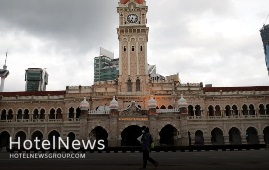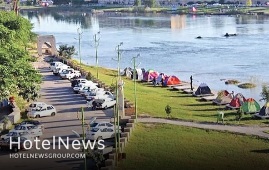
Iran has reduced the validity of negative COVID-19 PCR test results from 96 hours to 72 hours for inbound and outbound passengers. According to the Health Ministry, and the National Headquarters for Coronavirus Control, people flying to or from Iran need to do their PCR test within 72 hours before their flights. The new regulation replaced a role that required to bar passengers from boarding if they do not have a negative COVID test within 96 hours of departure. Iranian citizens without a negative coronavirus PCR test result are subject to medical screening and quarantine for 14 days at their own expense, while non-Iranian nationalities without the certificate are not allowed to enter the country. All passengers are subject to the medical screening on arrival, and if they are suspected of having the disease, non-Iranian nationalities will be quarantined at a place specified by the Health Ministry at their own expense and Iranian citizens will need to self-isolate for 14 days. According to some Iranian airlines, passengers from the United Kingdom, Japan, Botswana, Zimbabwe, Namibia, Seychelles, Angola, Mozambique, Lesotho, Malawi, Zambia, and Mauritius, as well as the travelers who have stayed in these countries for two weeks before entering the Iranian border, due to the spread of a new variant of the coronavirus in these regions, are not allowed to enter the country. The worldwide outbreak of COVID-19 has brought the world to a standstill, and tourism has been the worst affected of all major economic sectors. World tourist arrivals fell by 72% over the first ten months of 2020, according to data compiled by the World Tourism Organization (UNWTO) in December. Restrictions on travel, low consumer confidence, and a global struggle to contain the coronavirus pandemic are amongst factors contributing to the worst year on record in the history of tourism. Iran has also suffered the same fate as its foreign arrivals plunged 72% during the first eight months of 2020 when compared to 2019.
Create: Feb 13, 2021 Edit: Feb 13, 2021 Regional News
Japan's travel surplus in 2020 shrank to nearly one-fifth of the previous year, the first drop since the balance turned into the black in 2015, as international travel bans amid the coronavirus pandemic had a huge impact on the number of inbound visitors, government data showed Monday. The travel balance, which reflects the amount of money foreign visitors spend in Japan versus Japanese spending abroad, tumbled 79.2 percent to 562.1 billion yen ($5.3 billion) from a record 2.70 trillion yen in 2019 since annual comparable data became available in 1996, the Finance Ministry said in a preliminary report. Still, Japan's travel balance in 2020 logged black ink for the sixth straight year. In 2015, the balance saw its first black ink of 1.09 trillion yen since data compilation began in 1996, following a 44.4 billion yen deficit marked in 2014. Since 2011, when a massive earthquake, tsunami and the subsequent Fukushima nuclear crisis in northeastern Japan helped slightly widen a travel deficit to 1.30 trillion yen, the country's annual travel balance had continued to improve until 2019 with a steady increase in the number of foreign visitors. The reporting year's surplus in the current account, one of the widest gauges of international trade, fell 13.8 percent from 2019 to 17.70 trillion yen, its lowest level since 16.52 trillion yen recorded in 2015. It had increased 5.8 percent the previous year. In 2020, the goods trade balance saw a surplus for the fifth consecutive year, jumping almost eight-fold from the previous year to 3.05 trillion yen. The impact of a 15.0 percent decline in imports due to falls in prices of crude oil and other energy resources surpassed that of an 11.4 percent slip in exports amid sluggish demand for Japanese products such as cars and auto parts due to the pandemic. With the poor performance of the travel balance, services trade, which also includes cargo shipping, marked a 3.54 trillion yen deficit, following the first-ever surplus of 124.8 billion yen in 2019. It was the biggest red ink since the 3.81 trillion yen logged in 2012. The primary income balance, which reflects returns on overseas investments, showed a surplus of 20.72 trillion yen, the fourth largest since 1996, despite a 3.2 percent dip from a record 21.40 trillion yen in 2019, the first decline in four years. Many countries have imposed sweeping travel restrictions in response to the global spread of infections after the virus was first detected in China in late 2019. In 2020, 4.12 million foreigners visited Japan, which has promoted inbound tourism as a pillar of its growth strategy for revitalizing regional economies in recent years, plummeting a record 87.1 percent from 31.88 million in the previous year, according to the Japan Tourism Agency. Japan was originally scheduled to host the Tokyo Olympic and Paralympic Games last summer, but they were postponed for a year amid the pandemic. Largely consisting of tourists from China, South Korea and Taiwan, foreign visitors had kept expanding until 2019, when the figure hit a record high for the seventh year in a row. In December alone, Japan posted a current account surplus of 1.17 trillion yen, more than double the previous year's 544.9 billion yen to mark the 78th straight month of black ink. In the month, the country had a goods trade surplus of 965.1 billion yen and a services trade deficit of 343.5 billion yen. Primary income registered a surplus of 649.2 billion yen.
Create: Feb 8, 2021 Edit: Feb 8, 2021 International News
Iran has extended the ban on passenger flights to Britain until February 19 due to the spread of a new variant of the coronavirus, the Civil Aviation Organization of Iran announced. According to a statement by CAO on Saturday, the flights to and from the UK will remain suspended for another month, due to the new Covid-19 strain that is spreading rapidly in that country, Mehr reported. The measure was initially enforced on Dec. 22, 2020, for a fortnight at the request of the Health Ministry and the National Coronavirus Headquarters. The statement adds that in addition to the cancellations, the connection flights from other countries, especially European countries, have been completely restricted and controlled, and these restrictions continue until further notice. It is also specified that countries such as Japan, Zimbabwe, Namibia, Angola, Mozambique, Malawi, and several other countries where alarming mutant variants were reported as of January 21 were also subject to strict health laws, and those visiting or residing in such countries within the past two weeks were also banned from entering Iran.
Create: Feb 8, 2021 Edit: Feb 8, 2021 Regional News
Revenue loss in the international tourism sector in 2020 caused by a decrease in travelers crossing borders is estimated at $1.3 trillion, on the back of strict travel bans imposed by countries amid the coronavirus pandemic, a U.N. body said. Last year's international arrivals fell by one billion, or 74 percent, from 2019, ensuring that the overall estimated damage was over 11 times larger than in 2009 in the wake of the global financial crisis, according to a recent press release by the World Tourism Organization, a specialized agency of the United Nations. Due to the economic fallout from the virus spread, 100 to 120 million people have been put at risk of losing their jobs in the tourism industry, the Madrid-based body said, adding that many of them are from small and midsized business operators. "Global tourism suffered its worst year on record in 2020," the agency, also known as UNWTO, said in the news release, citing an "unprecedented fall in demand and widespread travel restrictions" to prevent the virus from further spreading. By region, Europe saw the largest drop in absolute numbers, with overseas arrivals down 500 million, or 70 percent, from the previous year. Meanwhile, those in Asia and the Pacific nations tumbled by 300 million, marking the sharpest decrease at 84 percent. On a percentage basis, the Middle East and Africa followed with a 75 percent plunge each, with the North and South Americas experiencing a 69 percent sink. As for 2021, a UNWTO panel of experts survey showed 45 percent of respondents forecast the situation will become better, while 30 percent predicted a deterioration, according to the press release. The remaining 25 percent expected a similar performance to 2020. The survey also showed that 43 percent think the tourism industry will rebound to pre-pandemic levels in 2023, with 41 percent saying it will happen in 2024 or later. UNWTO said that it expects the "gradual rollout of a COVID-19 vaccine" to bring about a recovery in consumer sentiment and eased travel restrictions, making travel relatively normal, albeit at a slow pace, during 2021. "While much has been made in making safe international travel a possibility, we are aware that the crisis is far from over," said Zurab Pololikashvili, secretary general of UNWTO. "The harmonization, coordination and digitalization of COVID-19 travel-related risk reduction measures, including testing, tracing and vaccination certificates, are essential foundations to promote safe travel and prepare for the recovery of tourism once conditions allow," the agency's chief added. Since first detected in the central Chinese city of Wuhan in late 2019, the virus has continued to spread globally and has resulted in over 105 million infection cases and more than 2.3 million deaths, according to data compiled by Johns Hopkins University.
Create: Feb 7, 2021 Edit: Feb 7, 2021 International News
Iran’s southeastern Sistan-Baluchestan province has lost 1,440 billion rials ($34.2 million at the official exchange rate of 42,000 rials per dollar) in earnings from tourism as many potential visitors stay away due to the impact of the coronavirus, according to Alireza Jalalzaei, the provincial tourism chief. “Sistan-Baluchestan is a four-season travel destination and even though the province holds vast tourism capacities, it has taken some 1,440 billion rials hit from the coronavirus outbreak from mid-Esfand 1398 (early March 2020) to the end of the month Dey (January 19),” the official said on Wednesday. The official noted that Sistan-Baluchestan has set sights on [a significant] tourism development, and its travel infrastructure has been drastically extended over the past couple of years. “From the year 1396 (2017) onwards, the number of travel infrastructure in Sistan-Baluchestan has raised from 40 to 200 ones…. Nowadays tourism of this province has come to fame and distinction,” he explained. Elsewhere in his remarks, the official pointed to various tourism campaigns being launched over the past couple of years, adding the campaign ‘Let’s see Sistan, let’s hear Baluchestan’ has taken a noticeable impact on the tourism thrive of the province mainly by the means of on-line programs. “Despite all the bottlenecks, the province’s tourism has not been forced to shut….” “For instance, the occupancy rate of hotels in [the city of Chabahar] is [currently] more than 90 percent….. and currently, some 100 to 110 ecolodge unites are active across the province,” the official said. Last year, Cultural Heritage, Tourism, and Handicrafts Minister Ali-Asghar Mounesan said that the development of the travel industry across Sistan-Baluchestan province is among the top priorities for the ministry. “I am interested in Sistan-Baluchestan, and the development of this province is a priority for this ministry and the government,” the minister stated. “The majority of my travels during my tenure has been to Sistan-Baluchestan, which I consider it as a safe province with significant values in terms of culture, history, handicrafts, and tourism.” The collective province -- Sistan in the north and Baluchestan in the south -- accounts for one of the driest regions of Iran with a slight increase in rainfall from east to west, and an obvious rise in humidity in the coastal regions. In ancient times, the region was a crossword of the Indus Valley and the Babylonian civilizations. The province possesses special significance because of being located in a strategic and transit location, especially Chabahar which is the only ocean port in Iran and the best and easiest access route of the middle Asian countries to free waters. The vast province is home to several distinctive archaeological sites and natural attractions, including two UNESCO World Heritage sites, namely Shahr-e-Soukhteh (Burnt City) and Lut desert.
Create: Feb 6, 2021 Edit: Feb 6, 2021 Regional News
The Jordan Tourism Board has partnered with workspace operator Venture X to launch a dedicated accelerator for tourism start-ups. The accelerator will be a “highly selective, equity-based three-month programme for the most promising technology start-ups or pre-scale-ups that can power the travel and tourism industry”, according to a statement from the tourism board on Wednesday. “This partnership is a response to the challenges ahead,” Abdul Razzaq Arabiat, the board's managing director, said. The accelerator programme is looking for innovative companies that are developing ways to “future-proof” Jordan’s travel and tourism industry, the statement said, as tourism companies look to rebound in the wake of Covid-19. The collapse in international travel due to the pandemic led the global tourism industry to lose $1.3 trillion in export revenue, almost 11 times more than the loss recorded during the 2008 global economic crisis, according to the UN World Tourism Organisation. Companies selected to take part will undergo a three-month intensive programme to identify a potential pilot project and scope, followed by three months of implementation working alongside the top 10 industry partners, the statement added. “The pandemic is going to change the tourism industry,” Yousef Hamidaddin, managing partner of Venture X, said. “Innovative solutions will allow people to continue to travel and explore, which represents an opportunity for entrepreneurs and start-ups.” Jordan was chosen by Lonely Planet as the Most Welcoming Destination of 2021. The country reopened to travellers in September 2020 after restrictions due to Covid-19. The tourism industry contributes 13 per cent to 15 per cent of the country’s gross domestic product and employs almost 60,000 people. The pandemic came months after a record-breaking year for tourism, with the kingdom attracting one million visitors and generating 4.1 billion Jordanian dinars ($5.8bn) in 2019.
Create: Feb 4, 2021 Edit: Feb 4, 2021 International News
Well-planned travels during the Persian New Year (Noruz) holidays, which will start on March 20, would be possible in close coordination with the National Headquarters for Coronavirus Control, the deputy tourism minister said on Tuesday. In order to create social vitality during the holidays, the ministry has set some rules for possible Noruz trips to control and monitor them carefully, Vali Teymouri said. “The trips will be possible only within the framework of planned tours through licensed travel agencies and under the supervision of the tourism ministry.” For people, who travel individually and outside of the tours, a reservation for an authorized accommodation center will be necessary, the official added. He also emphasized that all travelers and tourists need to follow strict health protocols during their trips and stays. Last March, which is the most bustling and booming period for the tourism sector because it culminates in Noruz, all celebrations were canceled in all 31 provinces across the country, and all museums and historical sites, affiliated with the Ministry of Cultural Heritage, Tourism and Handicrafts went on a lockdown due to the coronavirus pandemic. Last year, before the Persian New year, the tourism minister Ali-Asghar Mounesan asked people to postpone or reschedule tours to help the tourism industry deal with the coronavirus outbreak. “My suggestion to my dear people is that they do not cancel their hotel reservations and domestic tours as far as possible to help the tourism industry and prevent it from bankruptcy by making their reservations in time after the virus is controlled.” Iranians made 74 million overnight stays in their domestic trips during the Noruz holidays two years ago (2019), which showed a 20 percent increase year on year. And some 132 million visits to tourist attractions were registered during the mentioned period, which showed a 34 percent growth year on year, according to data compiled by the Ministry of Cultural Heritage, Tourism and Handicrafts. The Islamic Republic was ranked the third fastest-growing tourism destination in the globe in 2019, with 27.9 percent growth year on year, according to the latest statistics released by the United Nations World Tourism Organization (UNWTO). However, the country expects to reap a bonanza from its numerous tourist spots. Under the 2025 Tourism Vision Plan, it aims to increase the number of tourist arrivals from 4.8 million in 2014 to 20 million in 2025.
Create: Feb 4, 2021 Edit: Feb 4, 2021 Regional News
The coronavirus crisis cost the global tourism sector $1.3 trillion in lost revenue in 2020 as the number of people traveling plunged, the UN said, calling it "the worst year in tourism history". Revenue lost last year amounted to "more than 11 times the loss recorded during the 2009 global economic crisis," the Madrid-based UN World Tourism Organization (UNWTO) said in a statement, warning that between 100 million and 120 million direct tourism jobs were at risk, AFP reported. International tourist arrivals fell by one billion, or 74 percent, in 2020 with Asia, the first region to feel the impact of COVID-19, seeing the steepest decline, it added. "While much has been made in making safe international travel a possibility, we are aware that the crisis is far from over," UNWTO head Zurab Pololikashvili said in the statement. The rollout of COVID-19 vaccines is expected to "slowly normalize travel" in 2021 but many countries are reintroducing travel restrictions such as quarantines, mandatory testing and border closures "due to the evolving nature of the pandemic", the body said. The Asia and Pacific region recorded an 84 percent drop in arrivals. It was followed by Africa and the Middle East with a 75 percent drop, Europe with 70 percent fewer visitors "despite a small and short-lived revival in the summer" and the Americas where arrivals fell by 69 percent. International tourism arrivals rose by four percent in 2019 to 1.5 billion, with France the world's most visited country, followed by Spain and the US. The last time international tourist arrivals posted an annual decline was in 2009 when the global economic crisis led to a four percent drop. The UNWTO said most experts do not see a return to pre-pandemic levels of tourism activity before 2023. Open-air and nature-based tourism will see growing demand when tourism restarts, with domestic tourism also expected to be more popular, the body said. While international tourism has taken a hit from the outbreak of disease in the past, the coronavirus is unprecedented in its geographical spread. By comparison, international tourism arrivals fell by just 0.4 percent in 2003 after the outbreak of Severe Acute Respiratory Syndrome (SARS) which killed 774 people worldwide. The coronavirus has killed at least 2,176,000 people since the outbreak emerged in China in December 2019, according to a tally from official sources compiled by AFP. The tourism industry accounts for about 10 percent of the world's gross domestic product (GDP) and jobs.
Create: Feb 3, 2021 Edit: Feb 3, 2021 International News
With more than 50 unique vaccination plans across the United States, one’s access to the Covid-19 vaccine depends in large part on where one lives. In Wisconsin, mink farmers are being considered for the next phase of vaccine prioritization. In New Jersey, smokers can get priority access to the vaccine. In Colorado, journalists fall under the category of frontline workers. This complex system has given rise to a new type of pandemic travel – dubbed “vaccine tourism” – in which people cross state or even country lines to get earlier access. Without standardized protocol, and because of the fractured American health system, tens, if not hundreds, of thousands of people have gotten vaccines outside their home states. “They are coming from Canada, Brazil, New York, Georgia, folks from Minneapolis have come here. Some friends of mine in St Petersburg [Florida] told me that they were in a vaccination line with people from Venezuela,” said Dr Jay Wolfson, a professor of public health at the University of South Florida. He credits advertisements from international travel agencies with at least part of the vaccine tourist influx. “I get calls all the time from people saying, ‘Jay, can you get me in someplace?’ – and I can’t. And I won’t.” Florida has been one of the most popular vaccine tourism destinations for domestic and international travelers alike, due to the state’s initial policy of vaccinating anyone over the age of 65 years old. The state recently implemented new ID rules in an attempt to direct more vaccines to Florida residents, but not before about 50,000 out-of-state recipients got a dose. Though some of these vaccine recipients are seasonal state residents, or snowbirds, whose decision to spend the winter in Florida was unrelated to their vaccination prospects, many thousands have come to the state just for a shot. The 50,000 doses represent only about 3.4% of the total vaccinations administered in Florida, but even a small percentage going to out-of-state recipients in any state can affect the entire country’s vaccination infrastructure. “Administering a vaccine dose involves appointments, involves needles, involves human resources. And all of those resources that are vehicles for delivering doses of the vaccine are tied to a local community, state, or city in terms of allocation,” said Dr Kyle Ferguson, a postdoctoral fellow in the division of medical ethics at the New York University Grossman School of Medicine.
Create: Feb 2, 2021 Edit: Feb 3, 2021 International News
Qatar Airways has announced a temporary suspension on accepting new bookings from UAE to the United Kingdom. In a statement on Twitter, Qatar Airways said: "Qatar Airways has temporarily suspended acceptance of new bookings from UAE for the next 7 days due to UK government concerns." In the same tweet, Qatar Airways also stated that South Africa and Rwanda are also temporarily suspended with exceptions including GCC nationals as well as resident permit holders returning to other GCC countries. Furthermore, Qatar Airways also mentioned that "acceptance of previously booked passengers will be dependent upon COVID-19 protocols and government permission to enter the country of their final destination."
Create: Jan 30, 2021 Edit: Jan 30, 2021 International News
Global tourism suffered its worst year on record in 2020, with international arrivals dropping by 74% according to the latest data from the World Tourism Organization (UNWTO). Destinations worldwide welcomed 1 billion fewer international arrivals in 2020 than in the previous year, due to an unprecedented fall in demand and widespread travel restrictions. This compares with the 4% decline recorded during the 2009 global economic crisis. According to the latest UNWTO World Tourism Barometer, the collapse in international travel represents an estimated loss of USD 1.3 trillion in export revenues - more than 11 times the loss recorded during the 2009 global economic crisis. The crisis has put between 100 and 120 million direct tourism jobs at risk, many of them in small and medium-sized enterprises. Due to the evolving nature of the pandemic, many countries are now reintroducing stricter travel restrictions. These include mandatory testing, quarantines and in some cases a complete closure of borders, all weighing on the resumption of international travel. At the same time, the gradual rollout of a COVID-19 vaccine is expected to help restore consumer confidence, contribute to the easing travel restrictions and slowly normalize travel during the year ahead. UNWTO Secretary-General Zurab Pololikashvili said: “While much has been made in making safe international travel a possibility, we are aware that the crisis is far from over. The harmonization, coordination and digitalization of COVID-19 travel-related risk reduction measures, including testing, tracing and vaccination certificates, are essential foundations to promote safe travel and prepare for the recovery of tourism once conditions allow."
Create: Jan 29, 2021 Edit: Jan 29, 2021 International News
Iran’s tourism industry has suffered a loss of over 140 trillion rials (about $3.33 billion at the official exchange rate of 42,000 rials per dollar) since the outbreak of the coronavirus pandemic, Cultural Heritage, Tourism, and Handicrafts Minister has said. Although the worldwide outbreak of COVID-19 has brought the whole world to a standstill, the tourism industry has been the worst affected of all economic sectors, IRNA quoted Ali-Asghar Mounesan as saying on Sunday. However, efforts are being made by the government to help the tourism sector flourish again with continuous support and injecting supportive packages, he added. The government has allocated a total of 500 trillion rials (about $12 billion) to the corona-affected sectors, of which 200 trillion rials ($4.7 billion) will be given to the health ministry and the rest will be spent on other sectors, he explained. Earlier this week, the minister announced that the national budget bill for the next calendar year (starting on March 20) has proposed 70 trillion rials (about $1.7 billion) to support tourism businesses affected by the coronavirus pandemic. If the budget receives parliament’s approval, it will be spent on different sectors of the tourism industry, which has taken a major hit from the coronavirus outbreak over the previous months, he noted. Despite the toughest economic pressures and sanctions, the government has provided good support to all sectors of tourism, the minister said.However, there is hope that the beginning of mass vaccination against the coronavirus will provide better conditions for tourism and businesses related to this sector, he explained.Government’s care and support packagesIn late October, deputy minister Vali Teymouri announced that a new support package to pay loans to businesses affected by the coronavirus pandemic has been approved.Depending on the type and activity of the businesses, they could benefit from at least 160 million rials ($3,800) to nine billion rials ($214,000) of bank loans with a 12-percent interest rate, he said.The loans will be allocated to tourist guides, travel agencies, tourism transport companies, tourism educational institutions, eco-lodges and traditional accommodations, hotels, apartment hotels, motels, and guesthouses as well as traditional accommodation centers, tourism complexes, and recreational centers, the official explained.In September, Teymouri pointed to the 1.3 million tourism workers in the country, who are facing several issues due to the coronavirus crisis and said “This number, in addition to their households, includes a significant population that makes a living through tourism, who are needed to be considered in ministry’s decisions.”Back in August, Teymouri announced that the tourism ministry has approved a total budget of 4,920 billion rials (over $117 million) to support corona-affected tourism businesses, covering as much as 36,000 people working in the tourism sector.Tourism industry in critical situationIn October, Mounesan warned that Iran’s cultural heritage and tourism will be in a critical situation if the crises caused by the outbreak of the coronavirus continue.In August, the minister said that Iran’s tourism has suffered a loss of 12 trillion rials (some $2.85 billion) since the outbreak of the coronavirus pandemic.He also noted that the coronavirus pandemic should not bring traveling to a complete standstill. “Corona is a fact, but can the virus stop tourism? Certainly not. For us, the coronavirus is a new experience in dealing with crises that teaches tourism experts around the world how to deal with such a disaster, and thankfully governments are turning this into an opportunity for better planning.”Last April, the government announced it will support those who are grappling with fiscal problems by offering loans with a 12-percent interest rate. The Ministry of Cultural Heritage, Tourism and Handicrafts also suggested a rescue package for tourism businesses. The government has also allocated a 750-trillion-rial (about $18 billion) package to help low-income households and small- and medium-sized enterprises suffered from coronavirus concerns.Coronavirus may turn tourism into luxury itemIn June, the United Nations World Tourism Organization praised efforts made by Iran’s tourism ministry to manage the travel industry during the coronavirus pandemic. UNWTO Secretary-General Zurab Pololikashvili said in a letter to Mounesan that the country's measures have truly earned plaudits to mitigate the impact on tourism. “A series of measures that the Ministry of Cultural Heritage, Tourism and Handicrafts of Iran has taken, in accordance with the guidelines and recommendations of UNWTO, has truly earned plaudits as an effective practice to mitigate the impact on tourism,” the letter reads.Some experts believe that the coronavirus pandemic may turn tours and travels into luxury items as observing health protocols will raise the cost of travel in the country. Mohammad Ali Vaqefi, the vice president of the Iranian Tour Operators Association, warned that with the continuation of the coronavirus outbreak, tourists may prefer individual travel rather than tours, adding that they may also choose to go on a trip by their vehicles and stay in tents or in nature instead of hotels.In the global scene, part of the new travel puzzle is the jet-set mindset focusing on tough hygiene care and social distancing as cardinal guidelines for slowing the spread of the virus. So the average expenditure will be raised for a typical traveler particularly inbound passengers so lesser ones can afford to buy privacy and space and safer travel amenities.Iran expects to reap a bonanza from its numerous tourist spots such as bazaars, museums, mosques, bridges, bathhouses, madrasas, mausoleums, churches, towers, and mansions, of which 24 being inscribed on the UNESCO World Heritage list. Under the 2025 Tourism Vision Plan, it aims to increase the number of tourist arrivals from 4.8 million in 2014 to 20 million in 2025. The latest available data show eight million tourists visited the Islamic Republic during the first ten months of the past Iranian calendar year (started March 21, 2019).
Create: Jan 27, 2021 Edit: Jan 27, 2021 Regional News
